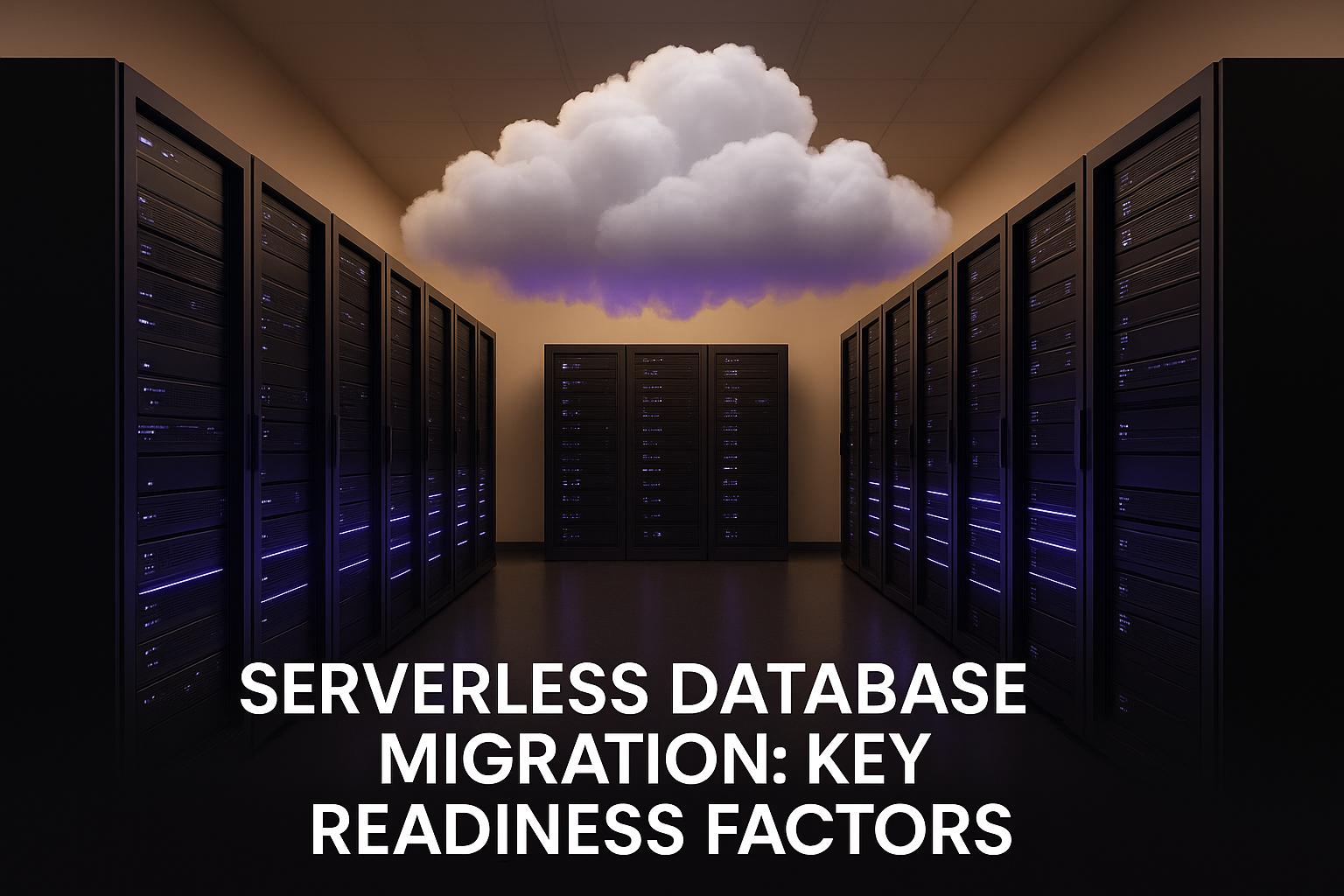Migrating to serverless databases can save costs, improve scalability, and simplify operations - but only if you’re prepared. Without proper planning, you risk downtime, data loss, and unexpected expenses. Here's a quick summary of what you need to know to ensure a smooth transition:
System Compatibility: Check your current database structure, dependencies, and data quality. Test with smaller datasets to catch issues early.
Data Security: Encrypt data, set strict access controls, and ensure compliance with regulations like GDPR or HIPAA.
Performance Optimization: Address cold starts, optimize queries, and test for varying workloads to avoid bottlenecks.
Automation Tools: Use tools like Liquibase or Flyway to streamline migrations and reduce human error.
Cost Management: Monitor usage, set spending limits, and optimize migration settings to avoid surprises.
Team Training: Prepare your team with hands-on training in serverless tools, security, and distributed systems.
Start small, plan thoroughly, and leverage automation to reduce risks and costs. These steps will help you transition effectively while avoiding common migration challenges.
Going Fully Serverless: migrating a live Prisma project from MySQL to PlanetScale with zero downtime

Main Readiness Factors for Database Migration
Understanding these critical areas can help ensure your database migration process goes smoothly. Below, we break down the key factors to prepare your organization for success.
System Compatibility Check
Start by taking inventory of all your data sources - traditional databases, flat files, cloud repositories, APIs, and legacy systems. Analyze their quality, structure, and how they interact. Cleaning up your data is crucial to avoid inconsistencies that could disrupt the migration process. Create a detailed mapping document outlining rules for each data element, including field names, formats, and any required transformations. Pay close attention to data dependencies like foreign key relationships, hierarchies, and linked records to maintain integrity during the migration.
It's also essential to consider the size of your data. Test the migration process using smaller, representative data sets in an environment that mimics production. This will help identify potential issues before moving everything over to the serverless setup.
Data Security and Legal Requirements
Security should be a top priority during database migration. With 43% of organizations experiencing data breaches in the past year, and the average cost of a breach reaching $4.24 million, the stakes are high. As IT Convergence emphasizes:
"Security during database migration is not an optional luxury; rather, it's a compulsory necessity." – IT Convergence
Begin by conducting a thorough risk assessment to identify vulnerabilities and compliance gaps. Develop a compliance strategy tailored to meet standards like GDPR, HIPAA, or PCI DSS, depending on your industry requirements. Protect your data by encrypting it both in transit and at rest, using strong encryption protocols. Implement strict access controls through Identity and Access Management (IAM) and Multi-Factor Authentication (MFA), following the principle of least privilege.
Vendor selection plays a crucial role in maintaining security. Ensure your chosen platform adheres to stringent data protection standards. For example, Help Desk Migration reported that careful vendor evaluation helped their clients reduce regulatory penalties by 10% compared to 2023.
"Ensuring data privacy and compliance during the migration process is not just a regulatory requirement. It's about building trust in your brand and avoiding unwanted issues (which will likely result in huge reputational and financial losses)." – Kateryna Butkovska
Finally, set up continuous monitoring and conduct regular security assessments to quickly identify and respond to emerging threats.
Performance and Scaling Planning
Once system compatibility and security are addressed, the next step is to optimize performance. A robust serverless setup should handle fluctuating workloads efficiently. Load testing is essential to ensure your architecture can manage expected traffic levels and to pinpoint bottlenecks or unexpected behaviors before going live. For instance, one test using Artillery revealed a median response time of 114 milliseconds, with cold starts causing delays of up to 1,401 milliseconds.
To reduce cold start delays, consider warming up functions, minimizing package sizes, and streamlining initialization code. Keep an eye on metrics like execution time, error rates, and invocation counts. Use feature flags and canary deployments to test updates safely. Additionally, understand the soft limits of your serverless platform so you can prepare for high traffic without running into throttling issues.
Optimizing database queries and implementing caching strategies for frequently accessed data can also help alleviate bottlenecks. Lastly, simulate a variety of load patterns to ensure your system performs reliably under varying traffic conditions. This approach ensures your architecture is ready to handle both predictable and unexpected scenarios effectively.
Automation and Cost Control Methods
Once you've addressed system compatibility, security, and performance, it's time to focus on automation tools and cost management strategies. These steps not only help reduce manual errors but also keep expenses in check.
Using Automation Tools
Automation in database migration is a game-changer. It minimizes human error and ensures consistency, turning a traditionally complex process into a smoother, more predictable workflow. Plus, it integrates seamlessly into CI/CD pipelines for ongoing efficiency.
One standout tool in this space is Liquibase, which has been downloaded over 100 million times. It uses change logs in formats like XML, YAML, JSON, or SQL to track schema changes. Liquibase supports multiple database types, making it a versatile choice for complex migrations. As Joe Albano, Senior Configuration Management Advisor, puts it:
"Liquibase brought our database changes and data correction processes up to speed with our code deploys which were already automated."
For teams looking for simplicity, Flyway offers an approachable solution. It uses SQL scripts for migrations and versioning, and its pre- and post-migration hooks make it ideal for straightforward migration tasks. Its user-friendly approach means teams can adopt it without requiring extensive training.
Redgate SQL Change Automation is tailored for SQL Server environments. It automates the entire database deployment pipeline and supports both migration-based and state-based models. This makes it a strong choice for organizations with complex SQL Server setups.
To ensure smooth database migrations, always store your change scripts in version control alongside your application code. This keeps everything synchronized. Also, choose tools that support rollbacks to handle migration failures effectively. Automated testing for database changes is another must-have - it ensures that updates don’t disrupt existing functionality.
Tool | Best For |
|---|---|
Liquibase | Database change automation |
Flyway | Simple database migrations |
Compliance and auditing | |
Redgate SQL Change Automation | SQL Server environments |
Database governance |
A DevOps engineer shared their experience:
"We use the Liquibase tool for DB deployment automations using the CICD process. It helped us a lot by reducing human error with the standard audit reporting structure integrated with it."
By automating database deployments, teams can achieve faster releases, improved audit trails, streamlined rollbacks, and better collaboration between development and database teams.
Once automation is in place, turn your attention to managing costs effectively.
Cost Management Tips
While automation improves efficiency, keeping costs under control is equally important - especially in serverless migrations. Serverless databases operate on a pay-per-use basis, offering flexibility but requiring close monitoring to avoid unexpected expenses.
Monitor Usage Patterns Continuously. Tools like AWS CloudWatch or Azure Monitor allow you to track resource usage in real time. Setting up alerts for usage thresholds can help you avoid surprises. Companies with strong monitoring practices often save around 15% by preventing resource overuse.
Optimize Your Migration Approach. Take advantage of pricing models like AWS DMS Serverless, which charges based on hourly capacity usage measured in DMS Capacity Units (DCUs). For instance, optimizing parallel-load features and adjusting settings like MaxFullLoadSubTasks and CommitRate can significantly reduce migration time and costs. In one case, migrating 1.5 billion Oracle records went from 60 hours to just 3 hours and 45 minutes.
Implement Selective Data Migration. Avoid migrating unnecessary data by using filters. This reduces both migration time and costs while minimizing downtime, allowing you to focus on critical data.
Set Spending Limits and Alerts. Use your cloud provider’s budget tools to configure spending thresholds and receive notifications when you’re nearing them. Resource tagging can also help identify and eliminate waste, with some organizations reducing costs by as much as 30%.
Leverage Cost-Effective Configurations. For temporary migrations or full-load tasks, single-AZ AWS DMS deployments are more affordable than Multi-AZ options, though they offer less data protection. For non-critical workloads, consider preemptible instances or spot pricing, which can cut compute costs by up to 80%.
Real-world examples highlight the impact of these strategies. DemandHelm, an ad-tech company, reduced cloud costs by 34% through strategic use of serverless resources. Meanwhile, organizations leveraging event-driven architectures have reported operational cost reductions of up to 50%.
The AWS Database Blog underscores the importance of this approach:
"In the realm of database migration, achieving cost optimization is paramount. It's not just about moving data; it's about doing so in a way that ensures every resource is utilized efficiently, infrastructure expenses are minimized, and the return on investment is maximized."
To make the most of serverless database migration, regularly evaluate and adjust your AWS DMS instances based on workload demands. This ensures you’re not paying for unused capacity at any stage - whether during full load or Change Data Capture (CDC). By combining automation with disciplined cost management, serverless migrations can be both efficient and economical.
Movestax provides integrated serverless database solutions that include built-in automation and cost control, making migrations smoother and infrastructure management simpler.
Team Preparation and Training
Migrating to serverless systems requires a capable and well-prepared team to navigate the new environment effectively. Unlike traditional database setups that demand constant oversight, serverless solutions handle many routine tasks automatically. This shift allows teams to concentrate on more strategic, high-impact activities. In fact, 60% of IT professionals have reported increased productivity after adopting serverless technologies, as they spend less time on maintenance tasks.
The first step in getting your team ready is understanding their current skill levels.
Finding Skill Gaps
Start by evaluating your team's existing capabilities. A cloud readiness assessment combined with a skills gap analysis can pinpoint areas where additional training is needed to manage serverless environments effectively.
Focus on these critical areas:
Performance optimization, cost management, and data modeling tailored to serverless systems
Security and compliance, especially understanding the shared responsibility model (where the cloud provider secures infrastructure, and your team manages code and configurations)
Monitoring and troubleshooting, using modern cloud tools to track performance metrics and set up alerts for unusual activity
Once gaps are identified, implement hands-on training programs to address these needs directly.
Training for Distributed Systems
Serverless databases often operate within distributed systems, which come with their own set of challenges. To ensure your team is prepared, they should have a solid grasp of:
Loose coupling and fault tolerance, two key principles for distributed architectures
Failure and recovery strategies, such as retry logic, circuit breakers, and fallback mechanisms
Distributed transaction management, including eventual consistency, distributed locks, and safe deployment practices
Best practices for generating unique identifiers, ensuring designs remain database-agnostic
Efficient architectural principles that minimize reliance on external dependencies
Security should also be a collaborative effort. Regular training sessions where development, operations, and security teams share updates and insights can keep everyone aligned. Pair these sessions with sandbox environments where team members can experiment with serverless databases in a risk-free setting. Encouraging this kind of cross-functional learning not only builds expertise but also sparks innovation, helping your team tackle migration challenges with confidence.
Investing in team preparation has long-term benefits. A well-trained team can harness the full potential of serverless databases while sidestepping common mistakes that can lead to overspending or performance issues.
Movestax supports this transition with detailed documentation and reliable assistance, giving your team the tools they need for a smooth migration and ongoing success.
Conclusion: Getting Ready for Migration
Switching to serverless databases can lower costs, improve scalability, and simplify operations. The rapid growth of the cloud migration market - from $232.51 billion in 2024 to a projected $806.41 billion by 2029 - shows just how many businesses are embracing these advantages.
Key Readiness Factors for a Smooth Migration
To ensure success, you’ll need to tackle several critical factors. System compatibility checks are a must. This involves carefully reviewing your current infrastructure and applications to identify any dependencies or mismatches that could cause issues.
Data security and legal compliance are equally crucial. Strong encryption, strict access controls, and well-configured authentication systems are essential to protect sensitive information. Overlooking these steps could expose your data to unnecessary risks.
Performance and scaling plans come next. Serverless databases automatically adjust to handle changing workloads, but proper setup is key to making sure they perform well for your specific needs right from the start.
Automation and cost management can lead to significant savings. Pay-as-you-go pricing models often cut operational expenses by as much as 40%, with some companies reporting savings of up to 70% compared to traditional solutions. Jamie Druce, Senior Web Developer at Content Ignite, shared:
"Our hosting costs have decreased by over 90% and we're running at about 25% of our capacity allowing us to quickly scale."
Finally, team training and preparation are essential. Educating your team on serverless tools and best practices will help avoid common mistakes like overspending or performance bottlenecks.
These factors act as a roadmap to guide your migration efforts.
Steps for Planning Your Migration
With the readiness factors in mind, it’s time to map out a solid migration plan. Start by defining clear goals and thoroughly understanding your current data environment. Setting a well-defined scope and clear objectives lays the groundwork for a smooth transition.
Conduct a migration readiness assessment to uncover potential roadblocks that could lead to downtime. This process should involve input from database administrators, application developers, and business leaders to determine which data sources need to migrate and which can stay put.
Begin with less critical databases before tackling essential systems. This phased approach allows your team to gain experience and fine-tune processes without jeopardizing core operations. Use smaller data sets to test and validate your migration strategy before scaling up.
Create a detailed timeline that includes rollback procedures. Schedule migrations during off-peak hours, use reliable monitoring tools, and have a robust disaster recovery plan in place. Document every step of the process to provide a clear guide for your team and valuable insights for future migrations.
Tools like Movestax can simplify the process. With built-in automation, cost management features, and instant deployment capabilities, Movestax aligns perfectly with the readiness factors outlined above. Its fully managed databases, automated workflows, and AI-powered infrastructure management tools provide the support needed to confidently navigate the migration journey.
Keep in mind that migration isn’t a one-and-done task. It’s an ongoing process. Stay informed about new cloud technologies, update your security protocols regularly, and continuously monitor performance to ensure your system meets your expectations.
FAQs
What challenges do organizations face when migrating to serverless databases, and how can they overcome them?
Migrating to serverless databases comes with its own set of hurdles, such as cold starts, vendor lock-in, and debugging challenges. Cold starts can slow things down when functions have been idle, which is a concern for tasks that demand quick responses. Vendor lock-in can make it tough to switch providers later, limiting your flexibility. Debugging, meanwhile, becomes more complex in serverless setups because the stateless nature of functions makes it harder to pinpoint issues.
To tackle these problems, you can take several steps. Using provisioned concurrency helps minimize cold start delays, ensuring better performance for critical tasks. Adopting multi-cloud strategies can reduce reliance on a single provider, easing future transitions. For debugging, observability tools that offer detailed logs and tracing can make troubleshooting much more manageable. When it comes to managing state across function calls, services like Redis or DynamoDB can streamline your architecture and boost reliability. Additionally, breaking applications into smaller, independent microservices can improve compatibility with serverless systems and enhance overall efficiency.
How can organizations ensure they meet data security regulations like GDPR or HIPAA during a serverless database migration?
To ensure compliance with data security regulations like GDPR or HIPAA during a serverless database migration, organizations should focus on a few essential steps:
Understand compliance requirements: Begin by thoroughly reviewing the regulations relevant to your industry. Make sure your data handling practices align with these standards. For instance, encrypt sensitive data both while it's stored (at rest) and when it's being transferred (in transit) to meet GDPR and HIPAA guidelines.
Use cloud-native security tools: Take advantage of built-in cloud features such as access controls, encryption options, and continuous monitoring. These tools can strengthen security and make compliance easier to manage.
Perform regular audits: Conduct periodic checks throughout the migration to confirm that all implemented security measures are functioning as intended and meet compliance standards.
By addressing these steps proactively, businesses can navigate a secure and regulation-compliant shift to serverless databases, reducing potential risks along the way.
How can I control costs and avoid unexpected expenses during a serverless database migration?
To keep costs in check and avoid surprises during a serverless database migration, it’s crucial to start with a detailed cost analysis. Take a close look at your current systems, pinpoint areas where resources are underutilized, and estimate the expenses tied to various migration strategies. This upfront planning gives you a solid grasp of what to expect financially.
Another smart move is to adjust your resources to fit your needs during the migration. For example, tweak instance sizes and scale resources dynamically to match workload demands, especially during intensive phases like full data loads or change data capture (CDC). This ensures you’re only using - and paying for - what’s necessary.
With careful planning and thoughtful resource management, you can stay on budget and steer clear of unexpected expenses.







